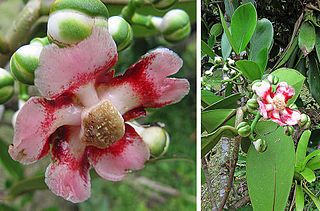
The Monimiaceae is a family of flowering plants in the magnoliid order Laurales. It is closely related to the families Hernandiaceae and Lauraceae. It consists of shrubs, small trees, and a few lianas of the tropics and subtropics, mostly in the southern hemisphere. The largest center of diversity is New Guinea, with about 75 species. Lesser centres of diversity are Madagascar, Australia, and the neotropics. Africa has one species, Xymalos monospora, as does Southern Chile. Several species are distributed through Malesia and the southwest Pacific.

Siparunaceae is a family of flowering plants in the magnoliid order Laurales. It consists of two genera of woody plants, with essential oils: Glossocalyx in West Africa and Siparuna in the neotropics. Glossocalyx is monospecific and Siparuna has about 74 known species.
Siparuna gentryana is an evergreen monoecious tree which grows to 20 m in height. It is found in primary forest habitats in western Ecuador and Colombia. It is similar to the more widespread Siparuna cristata but can be distinguished by its much smaller fruits which are spiny rather than smooth.
Siparuna lozaniana is an evergreen dioecious shrub which usually grows to 8 m in height. It is found in wet montane forest habitats in central Colombia. It can be distinguished from Colombian congeners such as Siparuna calantha and Siparuna petiolaris by the combination of leathery oblanceolate or obovate leaves and smooth rather than spiny fruits.
Siparuna calantha is an evergreen dioecious shrub which grows to around 10 m in height. It is found only in the Sierra Nevada de Santa Marta in Colombia. It is similar to Siparuna petiolaris but differs in having much broader leaves.
Siparuna vasqueziana is an evergreen dioecious shrub which grows to 5 m in height. It is found in primary forest habitats in Amazonian Peru. It can be distinguished from all other Siparuna species by its yellow flowers with exceptionally long tepals.

Kemp's gerbil is a species of rodent. Mammal Species of the World considers G. kempi and G. gambianus to be synonyms, however the IUCN has assessed each taxon as were they different species.

Clusia croatii is a species of flowering plant in the family Clusiaceae. It is found in Costa Rica and Panama, with one population in N Colombia. It is threatened by habitat loss.

The gracile naked-tailed shrew is a species of mammal in the family Soricidae. It is found in Burundi, Gabon, Kenya, and Uganda. Its natural habitat is swamps.

Helicia is a genus of 110 species of trees and shrubs, constituting part of the plant family Proteaceae. They grow naturally in rainforests throughout tropical South and Southeast Asia, including India, Sri Lanka, Indochina, Peninsular Malaysia to New Guinea and as far south as New South Wales.
Siparuna campii is a species of plant in the Siparunaceae family. It is endemic to Ecuador.
Siparuna cascada is a species of plant in the Siparunaceae family. It is endemic to Ecuador.
Siparuna eggersii is a scrambling, large shrub in the Siparunaceae family. It is endemic to Ecuador, where it is endangered due to habitat destruction. It has glabrous leaves and fig-like, red fruit with a lemon scent.
Siparuna guajalitensis is a species of plant in the Siparunaceae family. It is endemic to Ecuador.
Siparuna multiflora is a species of plant in the Siparunaceae family. It is endemic to Ecuador.
Siparuna palenquensis is a species of plant in the Siparunaceae family. It is endemic to Ecuador.
Siparuna piloso-lepidota is a species of plant in the Siparunaceae family. It is endemic to Ecuador.

The World's 25 Most Endangered Primates is a list of highly endangered primate species selected and published by the International Union for Conservation of Nature (IUCN) Species Survival Commission (SSC) Primate Specialist Group (PSG), the International Primatological Society (IPS), Global Wildlife Conservation (GWC), and Bristol Zoological Society (BZS). The IUCN/SSC PSG worked with Conservation International (CI) to start the list in 2000, but in 2002, during the 19th Congress of the International Primatological Society, primatologists reviewed and debated the list, resulting in the 2002–2004 revision and the endorsement of the IPS. The publication was a joint project between the three conservation organizations until the 2012–2014 list when BZS was added as a publisher. The 2018–2020 list was the first time Conservation International was not among the publishers, replaced instead by GWC. The list has been revised every two years following the biannual Congress of the IPS. Starting with the 2004–2006 report, the title changed to "Primates in Peril: The World's 25 Most Endangered Primates". That same year, the list began to provide information about each species, including their conservation status and the threats they face in the wild. The species text is written in collaboration with experts from the field, with 60 people contributing to the 2006–2008 report and 85 people contributing to the 2008–2010 report. The 2004–2006 and 2006–2008 reports were published in the IUCN/SSC PSG journal Primate Conservation,, since then they have been published as independent publications.







